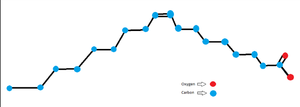Sandbox Reserved 1757
From Proteopedia
(Difference between revisions)
| Line 14: | Line 14: | ||
Mevalonate 3,5-bisphosphate is a homodimer made up of <scene name='93/934001/Secondary/1'>40% alpha helices and 60% beta-sheets</scene>. Because Mevalonate 3,5-bisphosphate is a homodimer both molecules present are <scene name='93/934001/Quat/1'>identical</scene> in primary, secondary, and tertiary structure. Mevalonate 3,5-bisphosphate is amphipathic as showcased by the surplus of hydrophobic as well as hydrophilic amino acids present in its <scene name='93/934001/Active_site/2'>Active Site</scene>. This<scene name='93/934001/Active_site/4'> view</scene> also shows us the large cleft for substrate binding present on the molecule. | Mevalonate 3,5-bisphosphate is a homodimer made up of <scene name='93/934001/Secondary/1'>40% alpha helices and 60% beta-sheets</scene>. Because Mevalonate 3,5-bisphosphate is a homodimer both molecules present are <scene name='93/934001/Quat/1'>identical</scene> in primary, secondary, and tertiary structure. Mevalonate 3,5-bisphosphate is amphipathic as showcased by the surplus of hydrophobic as well as hydrophilic amino acids present in its <scene name='93/934001/Active_site/2'>Active Site</scene>. This<scene name='93/934001/Active_site/4'> view</scene> also shows us the large cleft for substrate binding present on the molecule. | ||
== Other important features == | == Other important features == | ||
| - | + | As discussed in the Biological relevance portion of this page the ATP binding site from the suspected predecessors is still prevalent in Mevalonate 3,5-bisphosphate despite the protein not requiring ATP to function. | |
</StructureSection> | </StructureSection> | ||
== References == | == References == | ||
<ref>Aoki, M., Vinokur, J., Motoyama, K., Ishikawa, R., Collazo, M., Cascio, D., Sawaya, M. R., Ito, T., Bowie, J. U., & Hemmi, H. (2022). Crystal structure of mevalonate 3,5-bisphosphate decarboxylase reveals insight into the evolution of decarboxylases in the mevalonate metabolic pathways. The Journal of Biological Chemistry, 298(7), 102111–102111. https://doi.org/10.1016/j.jbc.2022.102111</ref> | <ref>Aoki, M., Vinokur, J., Motoyama, K., Ishikawa, R., Collazo, M., Cascio, D., Sawaya, M. R., Ito, T., Bowie, J. U., & Hemmi, H. (2022). Crystal structure of mevalonate 3,5-bisphosphate decarboxylase reveals insight into the evolution of decarboxylases in the mevalonate metabolic pathways. The Journal of Biological Chemistry, 298(7), 102111–102111. https://doi.org/10.1016/j.jbc.2022.102111</ref> | ||
| + | <ref>Vinokur, J M, et al. “7T71: Crystal Structure of Mevalonate 3,5-Bisphosphate Decarboxylase from Picrophilus Torridus.” RCSB PDB, https://www.rcsb.org/structure/7t71.</ref> | ||
<references/> | <references/> | ||
Revision as of 16:47, 13 December 2022
| This Sandbox is Reserved from November 4, 2022 through January 1, 2023 for use in the course CHEM 351 Biochemistry taught by Bonnie Hall at the Grand View University, Des Moines, USA. This reservation includes Sandbox Reserved 1755 through Sandbox Reserved 1764. |
To get started:
More help: Help:Editing |
Mevalonate 3,5-bisphosphate decarboxylase
| |||||||||||
References
[1]
- ↑ Aoki, M., Vinokur, J., Motoyama, K., Ishikawa, R., Collazo, M., Cascio, D., Sawaya, M. R., Ito, T., Bowie, J. U., & Hemmi, H. (2022). Crystal structure of mevalonate 3,5-bisphosphate decarboxylase reveals insight into the evolution of decarboxylases in the mevalonate metabolic pathways. The Journal of Biological Chemistry, 298(7), 102111–102111. https://doi.org/10.1016/j.jbc.2022.102111
- ↑ Vinokur, J M, et al. “7T71: Crystal Structure of Mevalonate 3,5-Bisphosphate Decarboxylase from Picrophilus Torridus.” RCSB PDB, https://www.rcsb.org/structure/7t71.

